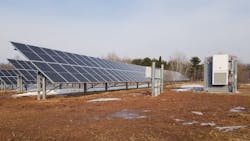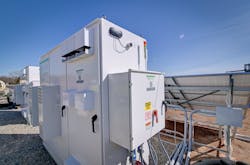4 Steps to Help Building Systems Achieve Sustainability Goals
Rising energy prices and persistent inflation are driving building owners to seek innovative approaches to reduce expenses. Prime areas for cost-cutting are energy usage and enhancing energy efficiency within buildings. To begin the journey toward smarter energy management, building managers can follow the Path to Smarter Energy™, a systematic process that enables facilities professionals to reach responsible business and energy objectives while also realizing financial gains.
You wouldn’t begin a road trip without a map, and the same goes for transitioning your existing operations to clean energy. You need a plan. By working with a clean energy solutions provider, you can reach your energy efficiency goals and improve energy usage with these four steps:
- Evaluate energy usage
- Prioritize conservation to lower energy usage
- Generate clean energy
- Achieve energy independence via energy storage
Step 1: Evaluate Energy Usage
To effectively conserve energy, it’s important to first understand your current energy usage. Your energy-saving steps will vary depending on your current usage and overall energy goals.
A great starting point is to review your utility bills, including rate structures, time of use tariffs, etc.; however, this alone does not give you the complete picture and can make it challenging to track your progress. That’s why for building managers, having effective energy metering and monitoring tools is crucial. These tools provide a comprehensive view of your energy usage, not just starting and ending points.
Beyond the tools that track energy use, building managers can also use an intuitive Energy Management System (EMS), which gathers and presents the data in a user-friendly manner. An EMS offers up-to-the-minute data on energy consumption, which provides insights into the causes of energy disruptions, faults or power quality irregularities. This can help prevent repetitive power outages and safeguard the equipment within the facility.
An EMS also helps building managers in future steps on the path. It provides immediate feedback on changes to their facility so they can continuously improve energy usage and make informed decisions about energy conservation. Further, it allows building and operations managers to determine how to size and optimally use renewable energy sources for their buildings.
Many organizations may want to skip energy assessments to begin energy conservation, and in some ways, they can. Energy engineers can provide you with lists of projects with estimated benefits without metering information. Some actions, like LED lighting upgrades or turning off/down equipment when it is not performing a specific function, can positively affect your utility bills.
When trying to understand the true impact of an energy efficiency or renewable energy plan, however, nothing beats having the actual data. Without metering data, it can be difficult to determine where energy conservation is needed or whether the changes you’ve already made have made an impact. Being able to demonstrate actual dollars saved and process emissions lowered with metering data makes it much easier to directly equate specific actions with results.
Step 2: Prioritize Conservation to Lower Energy Usage
Energy conservation is the second step on the path, providing opportunities for improved efficiencies and more strategic energy consumption. Common applications of energy conservation include:
- Converting to LED lighting
- Installing building controls
- Improving building HVAC systems
Several other energy conservation strategies that can be implemented in building operations include:
- Upgrading to modern, more energy-efficient equipment
- Tackling issues related to leaks, insulation and building enclosures
- Monitoring kilowatt-hour (kWh) or therms per product to provide clear insights into the best practices for analogous machines or processes
Step 3: Generate Clean Energy
After determining and optimizing an organization’s energy use, the third step examines the most appropriate distributed energy resources (DERs) for your specific building’s energy needs. Energy can be derived from a wide range of sources that include solar, wind, utilities and generators.
Many companies are interested in implementing renewable, clean energy as it is a way to be more energy-independent and visibly demonstrate your commitment to the environment. Solar is currently the most common renewable energy source, with the declining costs of solar panels and their increasing efficiency making them an attractive option for many organizations. Solar energy comes with several benefits:
- A variety of installation possibilities, tailored to accommodate space and budget constraints
- Little to no disruption of business activities during the installation process
- Low operational and maintenance expenses
Using the data from metering in step one, your energy partner can optimally scale solar or other clean energy assets to your operational and building energy needs. This will allow building managers to determine the most suitable locations for installing these assets on your existing power distribution equipment.
- Determining clean energy sources depends on several factors including:
- Geographic location
- How much the utility pays for power generated back to the grid
- The characteristic pattern of electricity usage at the facility
- The availability of electrical capacity within the existing power distribution equipment
- Whether this solar installation is part of a plan toward achieving energy independence in the future (step four)
When considering renewable energy production possibilities, this step also includes establishing project goals and evaluating the site and structures. It’s also important to consider all available incentives and tax credits that may be applicable, to maximize the return on investment (ROI) of the project. To design for the highest ROI and other sustainability measures, building managers should simulate energy usage against expected energy production over a one-year time frame. Comparable computations can be performed for other green energy sources as well.
Step 4: Achieve Energy Independence Via Storage
Once a facility has identified its energy consumption patterns, made efforts to reduce energy usage and started generating some of its own power, the final step toward energy independence is energy storage. Companies may choose to store power for a variety of reasons with backup power being the most common, especially in areas where power outages are frequent. Storing energy ensures continuity of operations by providing resilience against power loss. Additional benefits of energy storage include:
- Protection against expensive or unpredictable utility power
- Enhanced reliability and resilience of energy supply
- Flexibility to shift energy usage and reduce utility peak demand
- Progress toward sustainability goals
- Greater control over your energy future
One of the most common DER configurations includes solar, battery energy storage and utility power. This is called a microgrid, which is a local on-site power and energy system that can operate independently of the traditional grid, making it more efficient and reliable. Think of it as a small power plant that produces renewable energy on-site. Microgrids can be grid-tied or off-grid, based on what goals you are trying to achieve. Ultimately, renewable energy resources can provide power and help offset the costs of utilizing power from the traditional power grid.
Another important benefit to energy independence is cost savings. Microgrids can use stored energy to power facilities during periods when renewable sources like solar aren’t generating electricity. This reduces dependence on utility power, leading to significant energy savings in several ways including:
- Demand Shaving: Utilities may impose extra fees, referred to as demand charges, to cover the costs incurred from abrupt power spikes. By using stored energy to supply power during these spikes, you can reduce reliance on utility power and minimize these additional costs.
- Time Shifting of Energy: Energy produced by renewables during peak times can be stored and then used later in the day when production is low and utility costs are high. This approach can lead to significant savings. For example, a business that operates a large corporate campus with multiple office buildings and a significant daily energy load discovered that their electricity costs are highest during peak demand periods in the afternoon when air conditioning use is at its maximum. To solve this issue, the business uses solar panels for generating renewable energy and battery storage for storing excess power. The solar panels generate electricity during the day, some of which is used immediately by the campus, while surplus power is stored in the batteries. During peak demand periods, instead of drawing expensive power from the grid, this organization uses the power stored in the batteries.
- Energy Independence and Control: According to the U.S. Energy Information Administration (EIA), the average cost of electricity is increasing by approximately 3% per year. Microgrids provide a reliable energy solution with predictable costs. They offer control over power generation and storage, safeguarding against future price hikes.
As the nation increasingly adopts electrification, finding your organization’s place on the Path to Smarter Energy can empower you to capitalize on cost reductions and enhance energy efficiency. Most importantly, it offers you a well-defined plan and actionable steps tailored to meet your buildings’ unique energy requirements and objectives and ultimately, help you achieve your energy conservation and generation goals.
About the Author

Mike Collom
As director of strategic accounts for FTI, Mike Collom is responsible for developing and delivering on relationships with key partners to drive growth, especially in energy solutions and connected systems. He has a thorough understanding of the organization’s value and works closely with customers to deliver solutions that are resilient, efficient and sustainable.
Prior to joining the organization in 2017, Mike held a series of positions of increasing responsibility focused on industrial manufacturing technology development and leadership with Kimberly-Clark. He also led the industrial division of an engineering services company based in India. Mike holds a Bachelor of Science degree in Electrical Engineering from Michigan Technological University, Houghton, Michigan.
Outside of work, Mike enjoys driving, motorcycling, photography and traveling.


